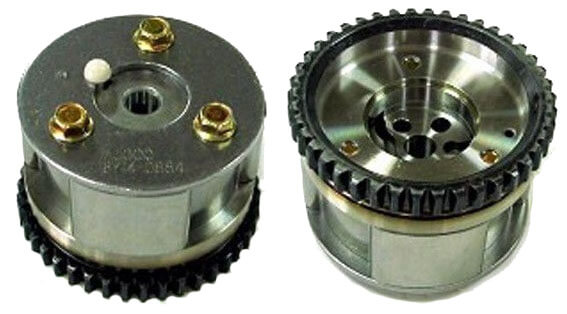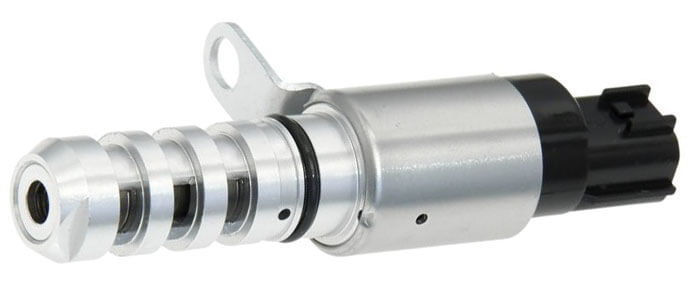P0011 Nissan
What does a P0011 Nissan code mean?
The P0011 Nissan trouble code is defined as P0011 Intake Valve Timing (IVT) CONTROL. Most carmakers use a variable valve timing (VVT) mechanism to advance or retard camshaft timing to gain the most performance and lowest emissions from the engine. The VVT mechanism sits at the front of the intake and exhaust camshafts and is rotated by the timing chain. The PCM determines how much to advance or retard the camshaft forward or backward to achieve those goals.

Nissan Variable Valve Timing Mechanism
The VVT mechanism consists of an advance and retard chamber. The chambers are filled or drained of motor oil by the oil control solenoid. A spring inside each chamber assists in pushing the oil out when the oil control solenoid is in the drain position.
The oil control solenoid doesn’t actually pump oil into the chambers. It relies on normal oil pump pressure to fill the chambers. It varies the speed of the fill and the amount of the fill by pulsing the solenoid on/off “X” times per second. The PCM relies on several other inputs to determine how long each pulse should be. Most importantly, the PCM assumes you’ve installed the recommended oil viscosity. Using the wrong oil viscosity can throw off the PCM calculations and cause a check engine light.
Nissan VVT inputs are:
Crankshaft position, derived from the crankshaft position sensor. This tells the PCM the engine speed and piston position.
Camshaft position sensor, derived from the camshaft position sensor.
Engine oil temperature. Assuming you’ve installed the recommended oil viscosity, the PCM can calculate how viscous the motor oil will be at a given oil temperature. Based on that, it can calculate the oil control solenoid on/off time.
Engine coolant temperature. The PCM needs this information to determine whether the engine is up to full operating temperature. In many cases, the PCM will either suspend or greatly decrease VVT activity while the engine is cold to reduce emissions.
Vehicle speed.
How the P0011 Nissan trouble code sets
Given all the inputs listed above, the PCM determines the preferred camshaft position and operates the oil control solenoid (also called a “phaser” because it changes the phase of the camshaft) to hydraulically move the VVT mechanism. It then compares the commanded (target) movement to the actual movement based on the camshaft position sensor reading.
When the actual movement doesn’t match the commanded target the PCM sets a P0011 Nissan trouble code.
Causes of P0011 Nissan
Incorrect oil viscosity
Dirty oil has degraded to the point where oxidation has occurred and the oil is more viscous than expected.
Sludge or varnish buildup inside the oil control valve that restricts solenoid movement or slows solenoid movement to the point where oil flow during activation is greatly reduced.
Failed oil control valve— either electrical or mechanical failure.
Crankshaft or camshaft position sensor error caused by debris buildup on the sensor pickup.
Stretched or damaged timing chain caused by oil change neglect.
Worn or damaged timing chain tensioner.
Diagnose and fix P0011 Nissan
Step 1: Check the oil condition. If the oil is dark and thick, change the oil and filter first. Then reset the trouble code and drive the vehicle. If the code returns, move to Step 2
Step 2: Check/replace the oil control solenoid
Set your mustimeter on the Ω scale. Touch probes to terminals 1 and 2. Resistance should read 6.7-7.7 Ω at temps 68°F or higher. Next, connect one lead to terminal 1 and ground. You should see ∞ or OL. Connect one lead to terminal 2 and ground. You should see ∞ or OL. If you see any other reading when testing to ground that indicates a short to ground in the solenoid coil and the solenoid must be replaced.
Next, remove the oil control solenoid and check for signs of debris, sludge, or varnish buildup. Apply battery voltage and ground to the solenoid terminals and check for movement. CAUTION: Do not apply power for more than 5 seconds! Doing so will overheat and damage the solenoid coil.

Oil control solenoid
If you find sludge in the oil control solenoid, perform several oil changes at 500-mile intervals to clean the engine. Or, in extreme cases of sludge buildup, perform an engine flush.
If the code returns, you may have a stretched timing chain or worn timing chain tensioner due to neglected oil changes.
Step 3: Check crankshaft and camshaft sensors for debris accumulation or damage
Step 4: Remove the timing chain cover and check the shaft on the timing chain tensioner. If it is fully extended, the chain has stretched and the tensioner has reached its limit. Replace the timing chain and tensioner.
©, 2020 Rick Muscoplat
Posted on by Rick Muscoplat